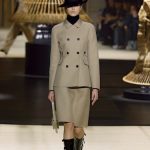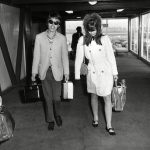On the cover of photographer Emanuel Hahn’s new book, Koreatown Dreaming, there’s a soulful photo of a man casually standing in front of a fruit truck. Surrounded by tangerines, strawberries, and mangoes, his demeanor is serene and proud at once, and his name is Sung Rae Yang, one of the many immigrants Hahn sought to honor in a new anthology of photographs and stories spotlighting Korean business owners across the US, published by Hachette Book Group and now available for purchase.
A Korean third-culture kid, Hahn grew up between Singapore and Cambodia, and never imagined he’d become a professional photographer. “I just never thought a career in the arts was possible for me,” he recently told W. Instead, Hahn moved to the US at the age of twenty, studied economics at NYU, and, shortly after, got a job in tech.
Entirely self-taught, now and then, Hahn would shoot wedding photos or portraits for friends, but it wasn’t until eight years ago, when he paid off his student loans, that he decided to try his luck as a full-time photographer.
“Photography gave me a tool not just to observe but to document. To share how I saw the world and what I thought was interesting,” Hahn said. “I just wanted to follow stories that I cared about.”
Utterly fascinated by diasporic experiences in the United States, Hahn has completed three photo series on the subject: The Mississippi Delta Chinese Project, The Korean-Uzbeks of Brooklyn project, and the forenamed Koreatown Dreaming. Later this year, during his artistic residency at New Wave in West Palm Beach, he’s set to complete America Fever, a fourth series that seeks to build on his body of work by delving into themes of cultural identity, history, and migration.
Hahn’s distinct proximity to his subjects and ability to honor the unique story of each sitter is tangible on every page of Koreatown Dreaming.
“I don’t know what the future holds for Koreans in America,” Hahn writes in the book’s introduction, “but in our communal seeking—for identity, for each other, for a place to call home—I feel I have found my people. I feel like I belong here.”
Below, a selection of photos from Koreatown Dreaming, with insights by Hanh.
According to Hahn, Sung Rae Yang’s portrait is on the cover of the book because it speaks to the project’s title, Koreatown Dreaming. “I chose the title because striving for your dreams is an ongoing process, and I felt like there was something about him, in front of this fruit truck, that suggests (his business) is not in its final form yet,” Hahn said
“Chinese Best Acupuncture and Herbs,” 2022
Courtesy of the artist.
Owner of Chinese Best Acupuncture & Herbs in Los Angeles, Peter Song migrated to the US in the eighties, seeking to obtain a degree in life insurance. Yet, difficulties with language led him to pivot into starting an acupuncture business. “Overtime, he has gleaned an extremely nuanced understanding of the body, beyond what Western medicine prescribes,” Hahn writes.
Seon Hee Chon started her business Music Plaza in 1992, seeking to bring Korean music to a homesick community. “Through the rise of YouTube and the popularity of K-pop in recent years, her store experienced a resurgence with most of her clientele now being non-Korean. There are throngs of K-pop fans that visit to purchase music albums and merchandise of their favorite bands,” Hahn explains.
“Home Mart Plus Co.,” 2022
Courtesy of the artist.
Yeon Sook Jo, a shopkeeper at Home Mart Plus Co, moved to the US in the seventies. “Despite intense competition from nearby stores, her kind demeanor and helpfulness, especially toward her older customers, have helped her business continue,” Hahn writes.
Great Grandmaster Yong Moon taught martial arts for more than fifty years. With Moorimgoong Martial Arts he sought to dissuade teens in Los Angeles from doing drugs and joining gangs. “A year after I took this photo, he passed away from cancer, and his son, who runs the school now, texted me to say the photo meant a lot because now they have an image that encapsulates everything his father was and stood for,” Hahn said.
Hanbok making has been in Laura Park’s family for generations. The owner of LeeHwa Wedding and Hanbok, she migrated to the US in the eighties and has worked to build a competitive business ever since. “She enrolled in FIDM, a fashion school in LA, in her 40s so that she could improve her design and sewing skills, and also to study what the younger generation found trendy,” Hahn writes.
“Kwak’s Antique Stores,” 2022.
Courtesy of the artist.
At 15 years old, Kevin Kwak began working as an apprentice in the antique furniture business. He moved to the US in his forties, where he opened Kwak’s Antique Furniture. “At first, he aspired to make beautiful custom furniture for his clientele but realized over the years that most people preferred cheap and mass-produced furniture,” Hahn writes. “Gradually, he pivoted his business to repairing furniture—many of his clients bring in antique pieces that have sentimental value that they want restored.”
In the late nineties, seeking to replicate the experience of South Korean street food halls (pojangmachas) in LA, Carol Cho founded Dan Sung Sa. “Her message is this: We are always humble and always here to serve—4 p.m. to 2 a.m. every day. All she wants is for people to get a taste of Korea and feel like they’re transported to a special place,” writes Hahn.
“Chun Ju Han-il Kwan,” 2022.
Courtesy of the artist.
The owner of Chun Ju Han-il Kwan, a well-established restaurant in LA’s Koreatown, Audrey Jang started her business in 1992 by developing a menu focused on budae jjigae (army stew). “She believes that she effectively introduced the dish officially to Americans for the first time,” writes Hahn. “(And) even as new Korean restaurants change their menu to feed a more diverse palate, her recipes have remained consistent since the beginning.”



